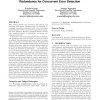18 search results - page 1 / 4 » Reducing resource redundancy for concurrent error detection ... |
HPCA
2006
IEEE
14 years 5 months ago
2006
IEEE
With reducing feature size, increasing chip capacity, and increasing clock speed, microprocessors are becoming increasingly susceptible to transient (soft) errors. Redundant multi...
IEEEPACT
2006
IEEE
13 years 10 months ago
2006
IEEE
With reducing feature size, increasing chip capacity, and increasing clock speed, microprocessors are becoming increasingly susceptible to transient (soft) errors. Redundant multi...
HPCA
2008
IEEE
13 years 11 months ago
2008
IEEE
With reducing feature size, increasing chip capacity, and increasing clock speed, microprocessors are becoming increasingly susceptible to transient (soft) errors. Redundant multi...
IOLTS
2006
IEEE
13 years 10 months ago
2006
IEEE
A significant fraction of soft errors in modern microprocessors has been reported to never lead to a system failure. Any concurrent error detection scheme that raises alarm every ...
ASPLOS
2004
ACM
13 years 10 months ago
2004
ACM
Recent studies have suggested that the soft-error rate in microprocessor logic will become a reliability concern by 2010. This paper proposes an efficient error detection techniqu...

